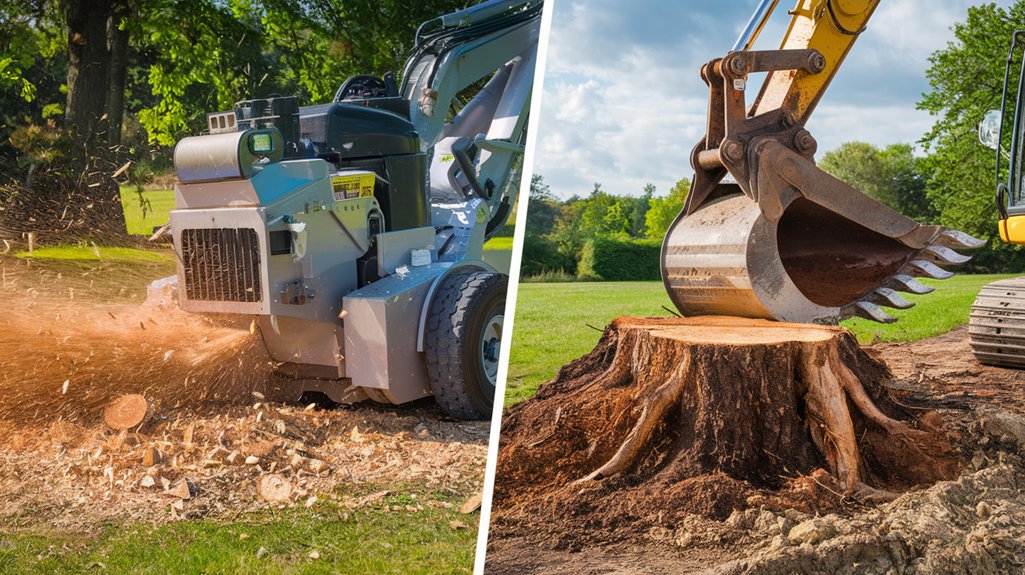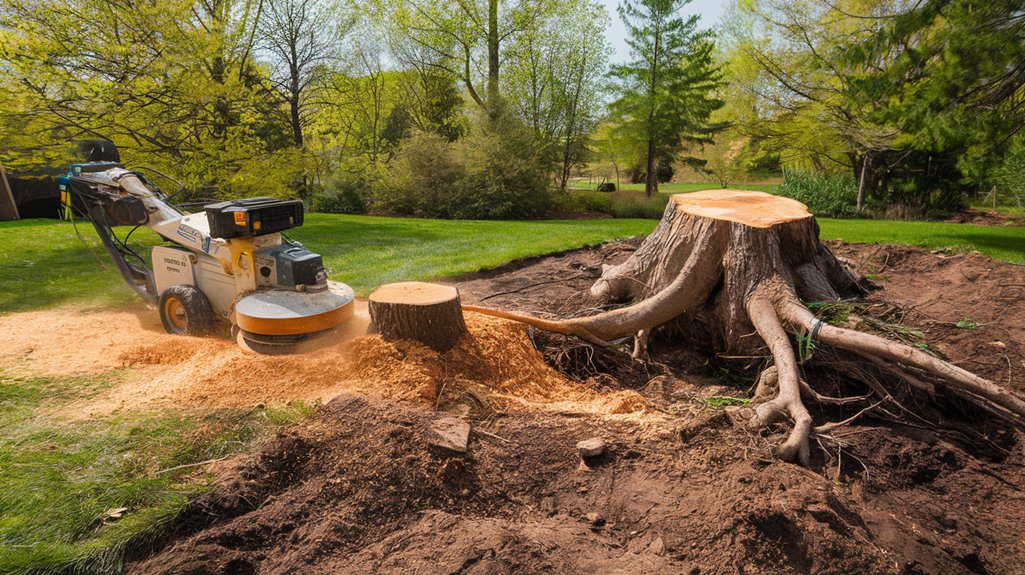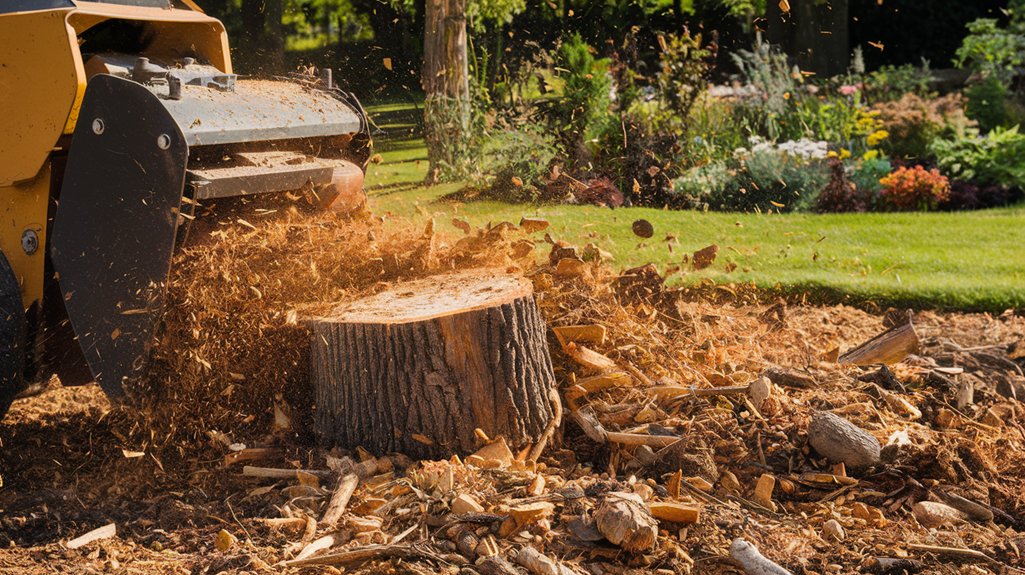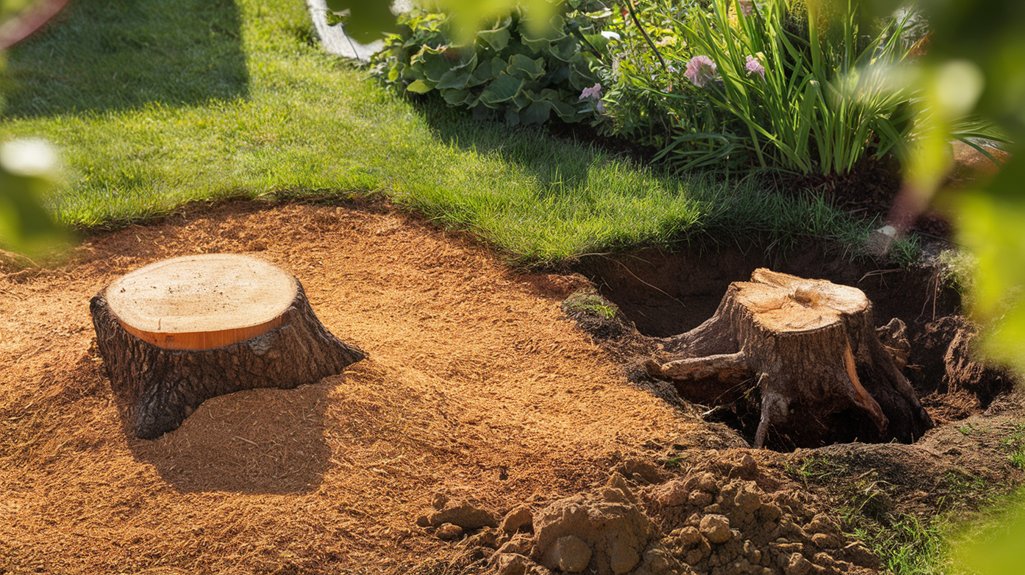When you’re faced with a tree stump on your property, choosing between stump grinding and stump removal can be a tough decision. Each method has its own set of advantages and drawbacks that can affect your landscaping and future plans. It’s important to weigh your options carefully to find the best fit for your needs and budget. So, what factors should you consider before making your choice?
- Stump grinding is quicker and less labor-intensive, often completed within hours, making it a convenient option for property owners.
- Stump removal provides a thorough solution, eliminating the stump and roots, preventing future decay and issues in the landscape.
- Stump grinding leaves useful mulch for landscaping that enriches soil, while removal may create a hole needing backfilling and restoration.
- Environmental impact favors stump grinding, promoting faster decomposition and less soil disturbance compared to the more invasive stump removal process.
Understanding Stump Grinding

When you’re faced with a tree stump in your yard, stump grinding is often the quickest solution. This process involves using specialized stump grinding equipment to effectively reduce the stump to wood chips.
You’ll find that various stump grinding techniques can be employed, depending on the size and condition of the stump. For instance, some grinders use a rotating blade to chip away at the wood, while others may utilize a drum-style grinder that can tackle tougher stumps.
The benefits of stump grinding include a clean yard and the ability to plant new greenery in that space. By choosing the right equipment and technique, you can reclaim your yard without the hassle of full stump removal.
Learn tree care from Colorado State University Extension.
Understanding Stump Removal

Though stump grinding is a popular choice, stump removal offers a more comprehensive solution for dealing with tree stumps.
When you opt for stump removal, you’re not just eliminating the visible part of the stump; you’re also addressing the root systems beneath the surface. This ensures that any potential for stump decay is eliminated, preventing future issues like pest infestations or disease.
Removing the entire stump allows you to reclaim your yard space without worrying about regrowth or the roots interfering with other plants. It’s a more thorough approach, especially for properties where landscaping and planting are essential.
If you’re looking for a long-term solution, stump removal might be the best option for your property.
Pros of Stump Grinding

While stump removal has its advantages, stump grinding presents several compelling benefits that make it an attractive option for many homeowners.
First, stump grinding typically takes less time and is less invasive than removal, minimizing disruption to your yard. You’ll also save money, as grinding is generally more affordable.
The benefits overview doesn’t stop there; the ground-up mulch can enrich your soil, promoting healthier plant growth. Additionally, stump grinding has a lower environmental impact.
Unlike removal, which may leave a large hole, grinding produces wood chips that blend into your landscape without damaging surrounding plants.
Ultimately, choosing stump grinding allows you to efficiently manage tree remnants while enhancing your property’s natural beauty.
Cons of Stump Grinding
Although stump grinding offers several benefits, it’s not without its drawbacks. One major concern is the environmental impact. The process can leave wood chips and debris scattered around, which may affect the surrounding ecosystem.
Additionally, stump grinding doesn’t fully eliminate the roots beneath the surface. This means you might experience root regrowth over time, leading to potential issues with new sprouts or weakened soil. If you’re planning to replant in the same area, these regrowing roots can hinder your efforts.
Furthermore, stump grinding mightn’t address any underlying diseases in the tree, which could impact nearby plants. Weighing these cons against the benefits is crucial in deciding the best option for your property.
Pros of Stump Removal
When you choose stump removal, you’re opting for a thorough solution that eliminates both the stump and the roots entirely.
This method provides several benefits of removal, like preventing new growth from sprouting and reducing the risk of pest infestations. Without the stump, you can reclaim valuable space in your yard for new landscaping or recreational activities.
Additionally, removing the roots can improve soil health, as decomposing roots can sometimes attract fungi or harmful insects. From an environmental perspective, stump removal allows for better drainage and nutrient absorption in the soil, promoting a healthier ecosystem.
Ultimately, this option ensures that your property remains safe, aesthetically pleasing, and free from potential hazards associated with leftover stumps.
Cons of Stump Removal
Though stump removal offers various benefits, it also comes with some drawbacks that you should consider.
One major concern is the environmental impact; removing a stump often requires heavy machinery that can disturb the surrounding soil and ecosystem. This disruption can lead to erosion and damage to nearby plants.
Additionally, stump removal can affect your property value. If not done carefully, the excavation may leave unsightly holes or uneven ground, which can detract from your yard’s appeal.
You might also face a longer recovery time for your landscape, as the area will take time to regrow and stabilize.
Weighing these cons against the benefits is crucial before deciding on stump removal for your property.
Time Considerations for Each Method
Many homeowners find that time is a crucial factor when deciding between stump grinding and stump removal.
Stump grinding typically offers better time efficiency. The grinding process usually takes just a few hours, allowing you to reclaim your yard quickly.
On the other hand, stump removal can take significantly longer, often spanning several days. This method involves digging out the entire stump and its root system, which can disrupt your landscaping and require more labor.
If you’re looking for a speedy solution with minimal disruption, stump grinding is the way to go.
Consider your project duration when making your decision; it can greatly influence how soon you can enjoy your outdoor space again.
Impact on Landscaping and Future Planting
When considering the impact on your landscaping and future planting, it’s important to understand how each method affects the surrounding area.
Stump grinding leaves the root system intact, which can benefit soil health by maintaining nutrients and microbial activity. However, the grindings can create a low spot that may require additional soil to ensure a level surface for new plants.
On the other hand, stump removal clears everything, giving you a clean slate for fresh landscaping. This option enhances landscape aesthetics but may disturb the surrounding soil, potentially affecting its health.
Choosing the right method will influence how well your future plants thrive and how your landscape looks, so weigh these factors carefully.
Making the Right Choice for Your Property
Choosing the right method for dealing with a stump can feel overwhelming, but it doesn’t have to be. Start by considering your property aesthetics. If you want a clean look without the remnants of a stump, stump removal might be the way to go.
However, if you’re okay with a little wood left behind, stump grinding can blend more seamlessly into your landscape.
Next, think about the environmental impact. Stump grinding leaves wood chips that can enrich your soil, while removal may disturb more of your property.
Evaluate your priorities—whether you value the immediate appearance or the long-term benefits. Ultimately, your choice should enhance your property while aligning with your values and future landscaping plans.
Frequently Asked Questions
How Deep Do Stump Grinding Services Typically Go?
Stump grinding services typically go about 6 to 12 inches deep, depending on the tree type and grinding techniques used. This depth helps prevent regrowth while allowing you to plant new vegetation in the area.
Can I Plant New Trees Over a Ground Stump?
You shouldn’t plant new trees over a ground stump. Doing so can hinder tree health, as decomposing stump material competes for nutrients. Choose a clear area to ensure your new tree thrives without interference.
What Equipment Is Used for Stump Removal?
For stump removal, you’ll typically use a stump grinder, which comes in various types like portable or tow-behind. Other removal techniques include digging out the stump or using chemicals to accelerate decomposition.
Will Stump Grinding Attract Pests to My Yard?
Stump grinding can potentially attract pests, as the wood chips create a favorable environment for insects. To maintain your yard, ensure proper cleanup and consider regular maintenance to minimize pest attraction and keep your space healthy.
How Long Does It Take for a Stump to Decompose Naturally?
A stump typically takes several years to decay naturally, depending on factors like moisture and size. You’ll notice gradual breakdown during this natural decomposition process, which encourages soil health and supports surrounding plant life.
In conclusion, choosing between stump grinding and stump removal hinges on your specific needs and future plans for your property. If you’re looking for a quicker, cost-effective solution that enriches your soil, stump grinding might be the way to go. However, if you want to completely clear the area for new plants or structures, stump removal could be your best bet. Weigh the pros and cons, and then make the choice that aligns with your vision for your landscape.
Contact Us
Stump Grinding vs Removal with Above & Beyond Services enhances your Denver property. Call (720) 806-6378 or visit Above & Beyond Services for free quotes on stump management, tree care, and more.




